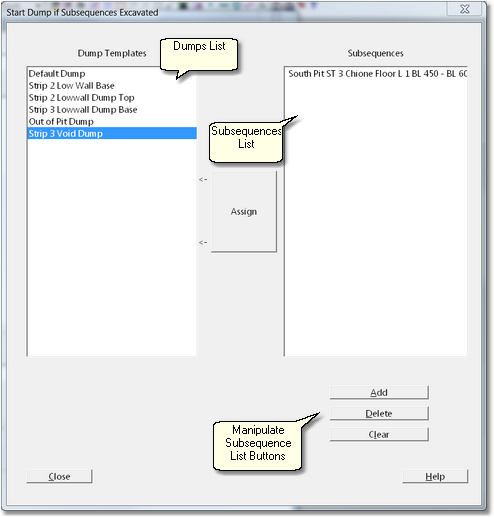|
<< Click to Display Table of Contents >> Subsequence Dependencies |
  
|
|
<< Click to Display Table of Contents >> Subsequence Dependencies |
  
|
Excavation Dependencies allow the use of particular dumps to be dependent on the completion (excavation) of a number of Subsequences.
When modelling multiple strips and multiple pit operations it is usually the case that the void created by each strip as it is completed will be used as a dump. It is critical that no material is placed in a void dump until the particular strip has been fully excavated. If the schedule is fixed then the availability of void dumps can be determined in advance and the user can ensure, via appropriate dump assignment, that a particular void only accepts material when its strip is complete. However frequently a variety of scheduling options are to be considered and these often involved varying amounts of advanced stripping. In such cases the user will not know in advance which void will be available for a particular Subsequence of advanced stripping.
The use of Excavation Dependencies allows all material excavated from strip "n" to report to a dump hierarchy commencing with the void dump for strip 'n-1'. If for a particular scheduling option strip 'n-1' has not been completed at the time that stripping for strip 'n' commences, the use of Excavation Dependencies will prevent the strip 'n-1' void dump being used and the material will report to the next available dump. Note that the next available dump itself may be subject to a Subsequence Dependency, so the dumping process will skip all initial dumps in the hierarchy whose dependencies have not been met and start at the first valid dump (dump who's void has been fully excavated).
Assigning Excavation Dependencies is done by clicking on the Assign Excavation Dependencies button in the Assign Dump Templates dialog (see figure above).This will open Excavation Dependency dialog:

Excavation Dependency Dialog.
On the left-hand side of the dialog is the Dump Templates list. This includes all Dump Templates in the file. To the right is the Subsequence is list. This contains a list of all Subsequences on which the selected Dumps will be dependent. This Subsequence list is assembled using the Manipulate Subsequence List buttons at the bottom right of the dialog. Once the Subsequences list is complete the Dumps to which the Subsequences will be applied as dependencies is selected from the Dumps list. The Assign button is then clicked and the Subsequence dependency is complete.
To modify or remove a Subsequence dependency the same process is applied but the Subsequences are removed from the list.
Subsequence Dependencies are further explained in the topic Dump Assignment for Complex Supersequences.
 Tip - Subsequence Dependency.
Tip - Subsequence Dependency.
The use of Subsequence Dependencies is critically important for multiple strip simulation and if a variety of schedules are to be modelled. However even in the case where a single schedule is to be used the use of Subsequence Dependency is still recommended. This will eliminate the possibility of inadvertent dumping within a strip which has not yet been fully excavated.